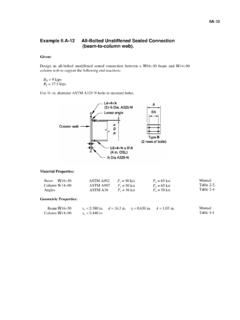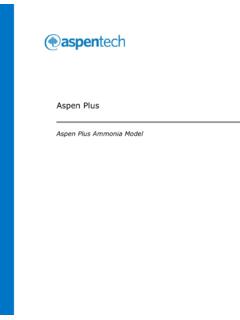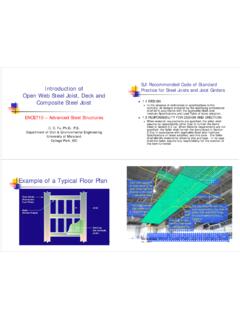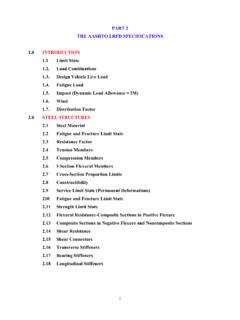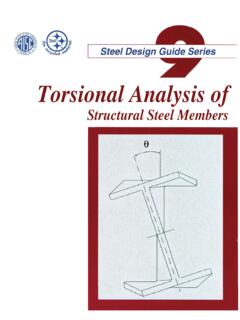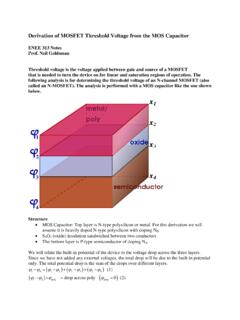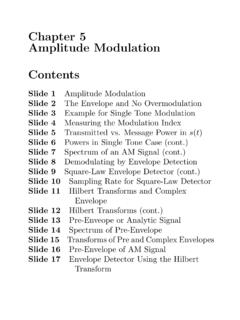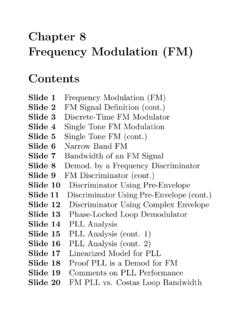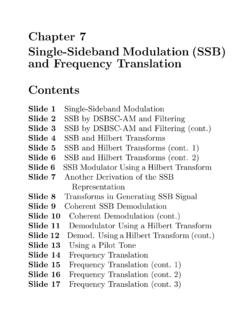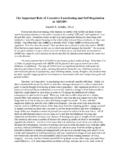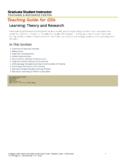Transcription of NAND Flash memory - UMD
1 NAND Flash memory Samsung Electronics, co., Ltd Flash design team 2010. 05. 07. Kihwan Choi - 1/48 - ELECTRONICS. Contents Introduction Flash memory 101. Basic operations Current issues & approach In the near future - 2/48 - ELECTRONICS. NAND Flash Application SSD. DMB phone Portable E-Book PMP Internet DVD player Telematics Mobile Digital TV. MP3 Digital 100GB. DSC Camcorder Game PDA Mobile & Consumer 20GB Oriented --Smart Smart phone 1GB. --MP3. MP3 Player 4GB. Compute --UFD. UFD 2GB. r --DSC. DSC 2GB. 2010. Serve --GAME. GAME 1GB 2007. r 2006 --Note Note book 2GB. 1GB --Camcorder Camcorder 8GB. ~1999 2002 --Smart Smart phone 32MB. --MP3. MP3 Player 128MB. --UFD. UFD 256MB. PC Oriented --DSC. DSC 128MB. --Note Note book 512MB. - 3/48 - ELECTRONICS. Flash memory in Wikipedia Flash memory is a non-volatile computer storage technology that can be electrically erased and reprogrammed. Flash memory offers fast read access times (although not as fast as volatile DRAM memory used for main memory in PCs) and better kinetic shock resistance than hard disks.
2 Flash memory (both NOR and NAND types) was invented by Dr. Fujio Masuoka while working for Toshiba circa 1980. According to Toshiba, the name " Flash " was suggested by Dr. Masuoka's colleague, Mr. Shoji Ariizumi, because the erasure process of the memory contents reminded him of the Flash of a camera. NAND Flash also uses floating-gate transistors, but they are connected in a way that resembles a NAND gate : several transistors are connected in series, and only if all word lines are pulled high (above the transistors' VT) is the bit line pulled low. - 4/48 - ELECTRONICS. Flash memory in Wikipedia To read, most of the word lines are pulled up above the VT of a programmed bit, while one of them is pulled up to just over the VT of an erased bit. The series group will conduct (and pull the bit line low) if the selected bit has not been programmed. NAND. Flash uses tunnel injection for writing and tunnel release for erasing.
3 One limitation of Flash memory is that although it can be read or programmed a byte or a word at a time in a random access fashion, it must be erased a "block" at a time. Another limitation is that Flash memory has a finite number of erase-write cycles. Most commercially available Flash products are guaranteed to withstand around 100,000 write-erase-cycles, before the wear begins to deteriorate the integrity of the storage - 5/48 - ELECTRONICS. Flash memory in Wikipedia Technology scaling down Reference: EETimes article on NAND scaling, 3/22/2010. - 6/48 - ELECTRONICS. Major players - 7/48 - ELECTRONICS. Now in the market . Intel, Micron and IMFT announce world's first 25-nm NAND technology February 2, 2010, By Sanjeev Ramachandran in Hardware The NAND Flash production scene has received a shot in the arm with Intel Corporation and Micron Technology making it public that the world's first 25-nanometer (nm) NAND technology is now on stream.
4 Significantly enough, the 25nm process is the smallest NAND. technology as well as the smallest semiconductor technology in the world Hynix Develops 26nm NAND Flash memory Tuesday, February 09, 2010. South Korea's Hynix Semiconductor Inc., the world's second-largest memory chipmaker, said Tuesday that it has developed a 26- nanometer based NAND Flash memory chip. The company is the world's second Flash memory maker to apply the below 30-nanometer technology. Mass production of the new memory will start in in July. Toshiba readies sub-25nm Flash memory chip production By Jose Vilches, Published: April 5, 2010, 12:14 PM EST. The company produces 32nm and 43nm memory chips, but the plan is to begin production on "sub-25nm" chips that would enable larger storage capacities to be shoved into the same form factors that we use today. Toshiba will begin output of NAND chips with circuitry widths in the upper 20 nanometre range soon, while production of chips with circuitry widths in the lower 20 nanometres is slated to start as early as 2012.
5 Samsung pioneers 20-nm NAND Flash memory technology April 19, 2010, By Thomas Antony in Storage Right on the heels of Toshiba's announcement to start on sub-25nm Flash memory , Samsung today announced the industry's first production of 20 nanometer class NAND chips for use in SD cards. Samsung's 20nm MLC 32-gigabit NAND chips are sampling now for use in embedded storage and SD memory cards ranging from 4GB to 64GB. This is a significant step forward for Samsung who started its 30nm production just one year ago. The new class of memory chips will allow for higher-density in storage, lower manufacturing costs and 50%. higher productivity than 30nm technology. - 8/48 - ELECTRONICS. Flash memory 101. - 9/48 - ELECTRONICS. Flash memory cell vs. MOSFET. Flash cell has a charge storage layer such that Vth of a cell can be changed memorize information G Charge storage G. S D S D. F/G. n n n n p p B B.
6 Flash cell MOSFET. - 10/48 - ELECTRONICS. Flash memory operation Write & read binary data to a Flash cell data 0' OFF' state (program). data 1' ON' state (erase). MOS Transistor Vg(Vg>Vth1). ON. No. of cells Read Vs(0V) Vd(>0V). Vth1. Program Ids1(>0). Erase Vg(Vg<Vth2). OFF. ON' OFF'. Vs(0V) Vd(>0V). Vth2. Vth [V] Ids2(=0). - 11/48 - ELECTRONICS. Flash memory cell structure Cell Vth changes depending on the amount of F/G charge electrons can be injected(ejected) into(out of) the F/G. through Tox with electric field across Tox B/L Metal Dielectric : ONO. C/G(W/L) Charge Storage Node F/G(F-Poly) Tunnel Ox Source Drain - 12/48 - ELECTRONICS. NAND vs. NOR. NAND NOR. A B C A B C. Truth table 0 0 0 0 0 1. 0 1 0 0 1 0. 1 0 0 1 0 0. 1 1 1 1 1 0. A A. Logic gate C C. B B. A B A. circuit C B. A C. Flash B A B. - 13/48 - ELECTRONICS. Features : NAND vs. NOR. - 14/48 - ELECTRONICS. Write methods in Flash memory Hot Electron Injection Fowler-Nordheim Tunneling Program in NOR Flash Program/Erase in NAND Flash Impact ionization at drain side Erase in NOR Flash - 15/48 - ELECTRONICS.
7 NAND Flash : Program & Erase Vcg = 18 V Vcg = 0V. 0V e e e e 0V float e e e e float Vsub = 0V Vsub = 20V. Program Erase F-N Tunneling F-N Tunneling Off cell On cell (Solid-0) (Solid-1). - 16/48 - ELECTRONICS. Coupling ratio C/G Vfg = Vcg cg CONO CONO. cg =. F/G (CD+CS+CB+CONO). CS CB CD cg : Coupling Ratio Source Drain (From Q=CV and Charge Conservation Law). For fast programming, high Vfg is required, either high Vcg or large cg - 17/48 - ELECTRONICS. NAND Flash cell structure BL DC Active SSL Gate SSL ONO. WL F-Poly WL. Tunnel Ox WL Direction F-Poly Gate ONO. F-Poly GSL Tunnel Ox PP-Well GSL. CSL CSL BL Direction Schematic Top View Vertical View - 18/48 - ELECTRONICS. Terms in NAND Flash string, page, block string : minimum cell array element page : program unit block : erase unit - 19/48 - ELECTRONICS. NAND Flash chip architecture High density & simple architecture (cell efficiency > 65%).
8 Control I/O Pad WL Decoder & Driver memory Array memory Array memory Array memory Array Block = 128-page (2Mb~4Mb). SLC : 64-page Page Driver & Buffer (2KB~4KB). MLC : 128-page Peripheral & Charge Pump Data I/O Pad Samsung 63nm 8Gb MLC NAND. - 20/48 - ELECTRONICS. Functional block diagram of NAND Flash X. X-Buffers A12~A30 - Latches D Cell Array & Decoders E. Y-Buffers C. A0~A11. Latches Data Register & S/A. & Decoders Y-Gating Command Command Register VCC. I/O Buffers & Latches VSS. Control Logic CE. & High Output RE Global Buffers I/O 0. Voltage Driver WE. Generator I/O 7. CLE ALE WP. - 21/48 - ELECTRONICS. Basic operations NAND Flash - 22/48 - ELECTRONICS. Read operation Bias condition - selected WL : Target voltage (Vtarget). - unselected WLs : high enough to conduct all cells in a string 1V. SSL Vread Vread Unselected WLs Vread Vtarget Vread Selected WL Vtarget Vread P1 P2. Unselected WLs Vread Vth Vread Vread Vread GSL Vread 0V - 23/48 - ELECTRONICS.
9 Sensing margin The ratio of On cell & Off cell current Sensing margin Precharge Level (Vp). Off cell Sensing Level On cell 0V. Precharge Sensing - 24/48 - ELECTRONICS. Read disturbance Increasing Vread soft program occurs in the unselected cell of selected string Vread Vread # of cell Vread Vread Vtarget Vread on 0V Vth Vread On cell moves to off cell Vread Vread Vread Vread - 25/48 - ELECTRONICS. Program operation Bias condition - selected WL : Program voltage (Vpgm). - unselected WLs : Pass voltage (Vpass). Vcc 0V Vcc SSL Vcc Unselected WLs Vpass # of cell Vpass Selected WL Vpgm Vpass on off 0V Vth Unselected WLs Vpass on cell becomes off cell Vpass Vpass Vpass GSL GND. - 26/48 - ELECTRONICS. Program inhibition Should not be programmed (= program inhibited). Vcc 0V Vcc Self boosting Vcc 0V Vpgm Vcc OFF. Vpass Vcc Vcc-Vth+ . Vpass Vpgm GND. Vpass Vcc Vpass Vpgm Vpass Vcc OFF. Vpass Vpass Vpass GND.
10 GND. For inhibition only, the higher Vpass, the better Vpgm disturbance But, higher Vpass causes more Vpass disturbance - 27/48 - ELECTRONICS. Self boosting Inhibit BL : Vcc SSL Vcc Bias sequence for self boosting WL31 10V. WL30 10V. Vpgm WL29 20V. WL28 10V. Vpass Inhibit channel is boosted !!! WL1 10V. WL0 10V. GSL 0V Program channel Channel potential strongly depends on the cell states in a string - 28/48 - ELECTRONICS. Vpass window Optimal Vpass region considering both Vpgm and Vpass disturbances at the same time Program cell Inhibit cell 0V VCC. Vpass Window Curve SSL VCC. Vth WL31 10V. Vpgm disturbance WL30 10V. Vpass disturbance WL29 20V. WL28 10V. -1V. WL1 10V. WL0 10V. Vpass GSL 0V Vpass window Vchannel = 0V Vchannel = 8~9V. - 29/48 - ELECTRONICS. Erase operation Bias condition - all WLs in the selected Block : 0V. - GSL/SSL : Floating - Bulk : Vera Floating GND # of cell GND.
